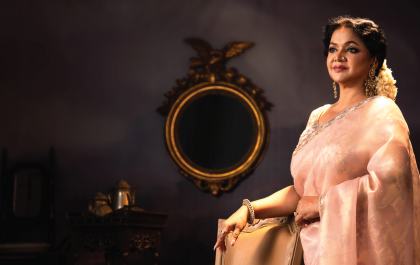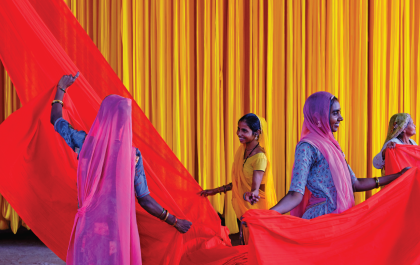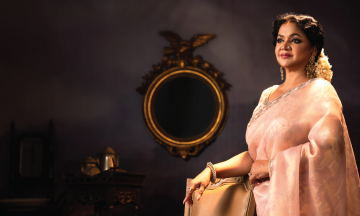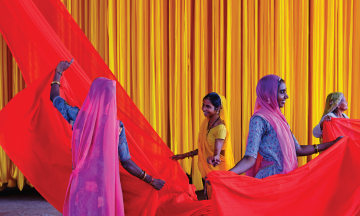Internationally renowned Bangladeshi painter Shahabuddin Ahmed has been bestowed with France’s highest civilian title for his contribution to art in France and all around the world. His paintings hang in the most prestigious of galleries all over the globe. Yet in his heart, he is ever the freedom fighter hoisting the flag of Bangladesh at the Dhaka Radio office (known as Pakistan radio back then) before noon. This is a happy reunion between the Shwadhinata Padak winner and MWB
By Sabrina Fatma Ahmad
When we arrive at his Kolabagan residence, Shahabuddin Ahmed is already at work. Dressed in his customary primary colors, waist girded by a gamcha, the septuagenarian is swinging his brush at a giant canvas. Although it is still at an early stage in the painting, that the subject is unmistakably Sheikh Mujibur Rahman, Bangabandhu’s distinct attire and features slowly coming into focus with each stroke. The artist’s signature Bacon-esque ‘wounded contours’ add a certain nostalgic quality to the work.
Shahabuddin has been painting the father of the nation for more than five decades, and I ask him if it’s all muscle memory by now, given that many of his favorite subjects are no longer with us and available to sit for him. He pauses to consider before answering, more to himself than to our crew, “Time blurs a lot of lines and details, but some things you can’t forget. Some things you mustn’t. Some people I don’t want to.”
I begin to understand that the conversation has shifted from the subject of his immediate painting to the chaos and turmoil of the birth of the nation. This is the first thing one comes to learn about the artist Shahabuddin Ahmed. He might be based in France since the 70’s, he might have his paintings on display all over the world, might be surrounded by friends, family and legions of admirers, but foremost on his mind at all times, is the spirit of Liberation.

SUCH GREAT HEIGHTS
Rafiqul Hoque Nantu, one of the partners behind the beloved bookstore Bookworm, and fellow freedom fighter recalls his training days at the Melaghar freedom fighter training camp in Agartala. ‘We’d already undergone about a month of training, and it was beginning to show in our stature, in the weeks’ worth of beard growth, skin tanned from hours under the sun, our attire reduced to the shabbiest of lungis and vests. And that’s when a fresh contingent of young recruits arrived from Dhaka, with their smart and clean attire and polished appearance. I’m not embarrassed to admit we felt a good bit of envy. We jokingly referred to them as the ‘Manja Party’ because our first impression of them was that they were very posh” he admits with a laugh. “Shahabuddin was already notable amongst the Manjas because we had heard about him winning the President’s gold medal for his art” he adds with a laugh. “We were proud to have such a luminary in our midst, but of course, a little jealous too.” Like many of the freedom fighters approached for their take, Rafiqul Hoque prefers not to dwell on the wartime experiences, but fast forwards to post Liberation, where he met Shahabuddin Ahmed thirty years after their first encounter. “By now, he was even more famous – he had won awards and sold many paintings, and was already listed as a living legend. But when we met, he greeted me like an old comrade, as equals. I have a photo of me holding my younger son Ariz, then a baby, and that photograph was taken by Shahabuddin.”
A much younger Shahabuddin Ahmed would probably have been delighted to be described as ‘posh’. He recalls how, as a precocious child hailing from a middle-class Bengali family, art was considered to be the purview of the wealthy. From as early as six years of age, Shahabuddin would show little inclination towards studies, pouring all his focus into painting and drawing, something that earned him many a thrashing from his parents. Despite their earnest wish to see their son pursue a more financially sound career, Shahabuddin’s mother was ultimately compelled by the boy’s passion to enroll him at the Shamsun Nahar Shishu Kala Bhaban. The artist recalls being so intimidated by the rich kids who attended the school, their attire and their polished English accents, to the point that he thought about feigning having lost interest in art altogether. A man named Hannan, who worked at the school, was the one to noticed both the child’s awkwardness and the burgeoning talent and convinced him to stay.
This Hannan would go on to convince the boy to submit his artwork to an art competition for Children’s Day, held in Karachi in 1968. Shahabuddin won the President’s Gold Medal as Best Child Artist, Pakistan
“Beauty is truth and truth beauty. The truth is always bright. It can never be concealed. The Liberation War is the foremost fact for the people of Bangladesh. It is our main pillar for existence, which gives us spirit and strength to survive” Shahabuddin Ahmed
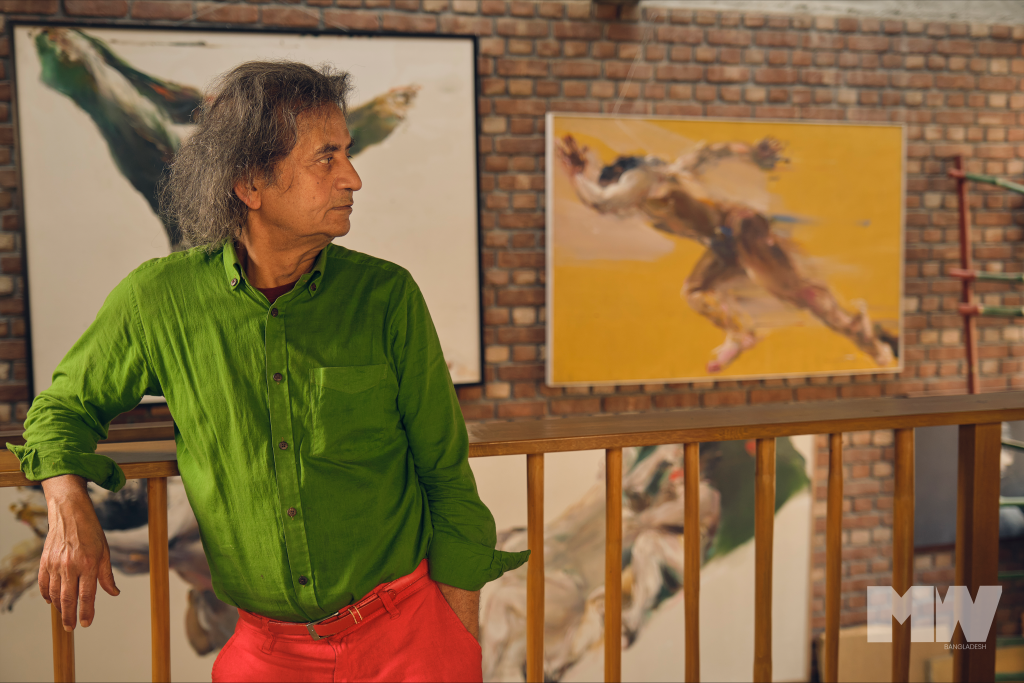
THIS IS HOW YOU REMIND ME
Spend any amount of time in Bangladesh and you will come to realize very keenly that this is a nation that hasn’t quite processed the trauma of the events leading up to and in the immediate aftermath of the Liberation War. Some of those who lived through it are reluctant to speak of the horrors that they witnessed. In the course of writing this piece, I was very gently rebuffed a few times when I went looking for freedom fighters to recall the events in their memory. Then there are others who cannot forget, and the terror and uncertainty of those days become a motif in their lives.
The Shahabuddin we celebrate lies at the intersection of nature and culture and is not only recognized through the “anthropological difference”, but also by way of the particularity of his artistic achievements impetus by the collective regeneration that had taken place during and after the liberation war. ~ Mustafa Zaman
Looking through Shahabuddin’s studio and the collections available online, at his ‘Freedom Fighter’ series and the untitled depictions of the Liberation War, one gets the feeling that the artist very much continues to inhabit the impressions of 1971. “Athletes or warriors in their tracks on the lookout, horned beasts or dog fighters, everything here translated simultaneously the irrepressible power of movement and raw violence”, writes Gérard Xuriguera of Shahabuddin’s work. “However, these figures never embodied in their concreteness, but loom, almost clandestine, in spasms of matter. The backgrounds chosen by Shahabuddin, compositions of beige paint, create an impression of infinite depth and push the artwork’s key subject forward.
“Therefore, in this conflict that was born and felt, strapped to organic wrench, Shahabuddin focuses on the essential rendering through a quest of depths which imposes a strong expression, in other words, close to the expressionism, in that it attempts to reveal the hidden side of the being.”
In between wardrobe changes for our cover shoot, the artist is hanging out by the pomegranate tree in his rooftop garden. I bite the bullet and ask him to talk about reconciling his role as a freedom fighter with his artistic ambitions as a youth.
“During waking hours, we had our roles to play. But the horrors…I would sometimes wake up screaming, because I was haunted by nightmares. I felt the urge to put all of this down in the language I knew best – art – because one of the things I feared losing was my art. I really hassled my comrades and superiors for supplies. And when one is literally fighting a war, art supplies aren’t easy to come by. Somehow, we managed ivory pencils and kajal, you know, like eyeliners, and I used the backs of calendars, banana leaves and twigs, anything I could use, to paint.” I ask him if he thinks that kept him sane.
“The experience of war has guided my path, but contrary to what many believe, I don’t paint war and war is in no way my creed. What I want to depict is the human suffering in defiant postures, borderline situations, in which the individual has to reach his limits. Nor do I choose death as a subject, because deep down, the nature of my interest is rather optimistic. And in the cracked attires of my characters, that some consider to be the reflection of the “freedom fighter” or the athlete, is nothing more than the manifestation of the state of one’s suffering.”
“The art of Shahabuddin is very personal, yet feels universal”
Balasz Takac
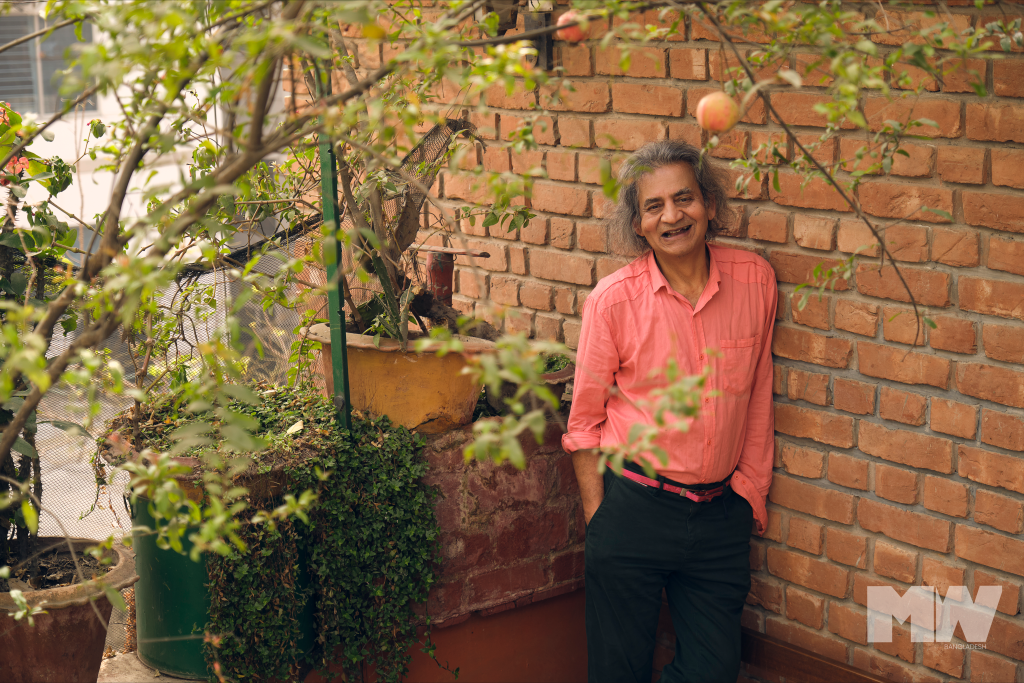
UNDER A DIFFERENT SKY
Shahabuddin has been living in Paris since 1975, after he obtained a scholarship at Ecole des Beaux-arts de Paris where he went for higher studies. He has talked about the difficulties of the early years there, his sense of alienation, his refusal to learn French, and his utter disinterest in assimilation. Like a scene from a movie, he met a French lady painting at the beach and helped bring her artistic vision to life and she took him under her wing and helped him settle in those foreign shores. Following his grief at learning about Sheikh Mujib’s assassination, eventually he learned to accept France as his new home. Shahabuddin Ahmed was awarded the ‘Ordre des Arts et des Lettres’ award in 2014 for his contribution to art in France and other countries. It is the highest civilian award in France. The story emboldens me to ask this freedom fighter why, in the first place, did he choose to leave the country he fought so hard to liberate.
“In 1971, I fought for the liberation of my country, now I’m struggling to become a good human being. I shall continue my struggle until the last moment of my existence” ~ Shahabuddin Ahmed
His answer is brief. ‘Bangabandhu’. Given the killing of intellectuals right before the declaration of victory, Sheikh Mujib was, in the words of the artist, simultaneously concerned for the safety of our surviving cultural assets, and also interested in their further development with view to nation building. “[Soon after the end of the war] there was a meeting between Sheikh Mujibur Rahman, Dr Sarwar Murshed, Zillur Rahman, Muhammad Yusuf Ali and Zainul Abedin. I was present at the meeting, and there were discussions about emigrating some of the younger intellectuals. The others proposed that I should go to New Zealand. But Bangabandhu suddenly declared: ‘My child will go to Paris. He will compete with the likes of Picasso. Ki re, parbi na? (What, you can do it, can’t you?)’ His words gave me confidence and I applied for and received the scholarship and left.” He is quick to assure me that he and his family proudly carry Bangladeshi passports, because no matter where he lives, he is always Bangladeshi first.
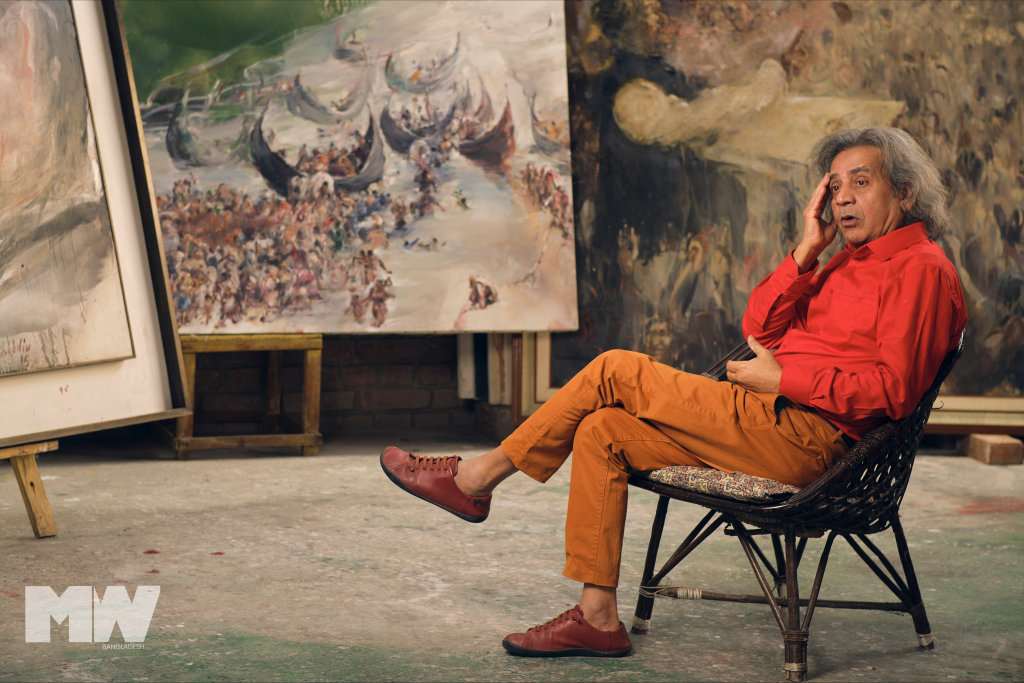
TRUE COLOURS
The red-bricked rooftop studio in Kolabagan, with its high ceilings, open windows and natural light, is suffused with the smell of paint and turpentine. The worktable where he keeps the tools of trade has acquired its own character, mounds of congealed paint create a topography of pigments. As the cameras are being set up, we talk about influences.
“Before I got into Dhaka Art College, I was deeply influenced by Zainul Abedin. He was my guru. It was my dream to be like him. In France, I discovered many more artists, and found inspiration in all their work. I feel like masters such as Goya, Rembrandt, Eugène Delacroix, Michaelangelo and Leonardo Da Vinci are my family.” I asked him if there was an artist he didn’t really like. Without hesitation, he says ‘Van Gogh’, responding to my further inquiries with a very Gallic shrug and an emphatic ‘Pah!’
Shahabuddin’s paintings are displayed in many prestigious galleries across the globe, including Museum Olympic Laussane, Switzerland and Bourn-En Brasse Museum, France.
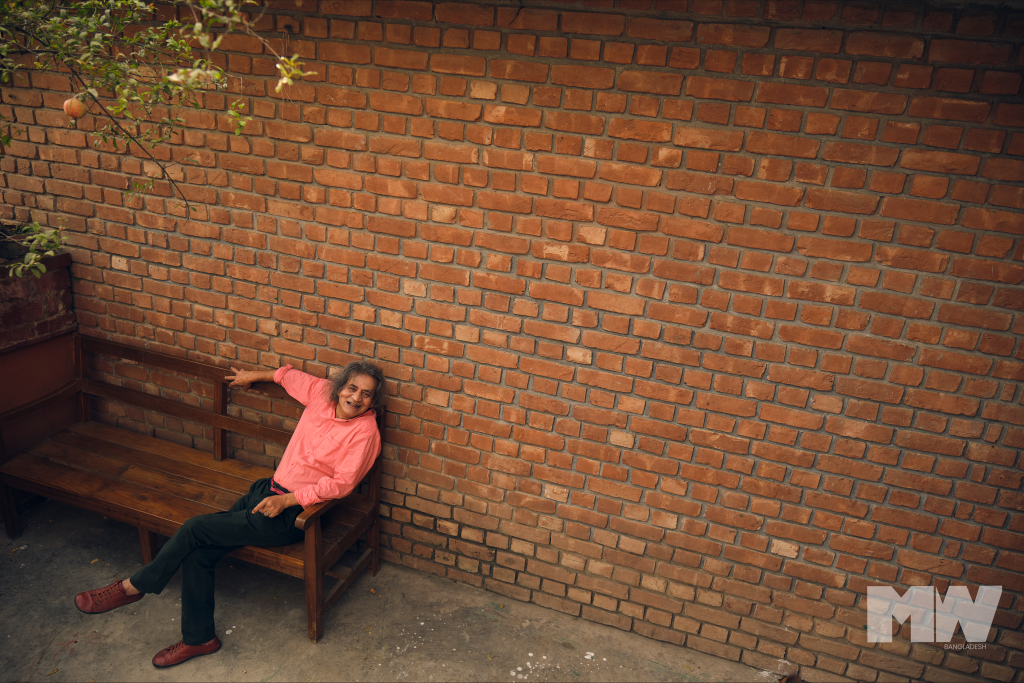
THE LIGHT THAT KEEPS BURNING
Our very first cover star for the MWB reboot was the Ekushey Padak winning painter Jamal Uddin Ahmed who talked about his impactful meeting with Shahabuddin Ahmed as a youth, and the lifelong friendship that had an impact on Jamal Uddin’s own illustrious career. The rambunctious raconteur that he is, the artist shared many stories about Shahabuddin, including the discussions on anatomy and form that led to Jamal Uddin’s life-altering decision to pursue further education in Poland.
In 1992, he became one of the fifty master painters of contemporary arts, an honor bestowed upon him at the Olympiad of Arts, Barcelona. National recognition followed under a decade later, with the Shwadhinata Padak in 2000. The prolific painter has continued to work tirelessly in building bridges between nations with his paintbrush, upholding the Bangladeshi spirit.
In 2016, alarmed by the rise in militant fundamentalist activity in Bangladesh, with the killings of bloggers by extremist elements, culminating in the Holey Artisan attack, Shahabuddin showcased a series of paintings in Mumbai on liberation. “I believe that with time, India and Bangladesh will devise a formula to contain this sickness that puts religion ahead of everything” he told the press.
In 2017, Shahabuddin Ahmed once again made history by becoming the first foreign artist to live in Rashtrapati Bhavan, the home of the-then Indian President Pranab Kumar Mukherjee, as an artist-in-residence. When asked about how it felt to do that, he says “It felt surreal. I was also very nervous as it’s a great honor. It’s not every day that one is invited by the President of one of the biggest democracies in the world.” The five-day residency culminated in ‘Shanti’, a solo exhibition of the artist’s work, comprising of 12 paintings of iconic figures of freedom like Mahatma Gandhi, Rabindranath Tagore Sheikh Mujibur Rahman. In an interview with the Indian media platform The Asian Age, he said “The south Asian continent is becoming a super power and the world is looking towards us. We are young, robust and have the strength to lead a peaceful life unlike the Western world, which is thriving through sale of weapons. We have never used weapons for power. With the teachings of Mahatma Gandhi, India and Bangladesh have shown the world that we have won wars through non-violence.”
Shahabuddin Ahmed’s work has been offered at auction multiple times, with realized prices ranging from 71 USD to 47,135 USD, depending on the size and medium of the artwork. Since 2006 the record price for this artist at auction is 47,135 USD for Untitled, sold at Asta Guru Auction House in 2023
From early morning till late afternoon, in between interview questions, wardrobe changes and sitting for photographs, making sure the MWB crew is well supplied with snacks and tea, grabbing his own lunch and putting in an hour or so of actual painting work, the energetic septuagenarian sends us off with a smile. He still has a whirlwind press tour to complete, art exhibitions to inaugurate. Standing at the door, we wave goodbye. “Joy Bangla!” he offers as parting words. “Joy Bangla!”





